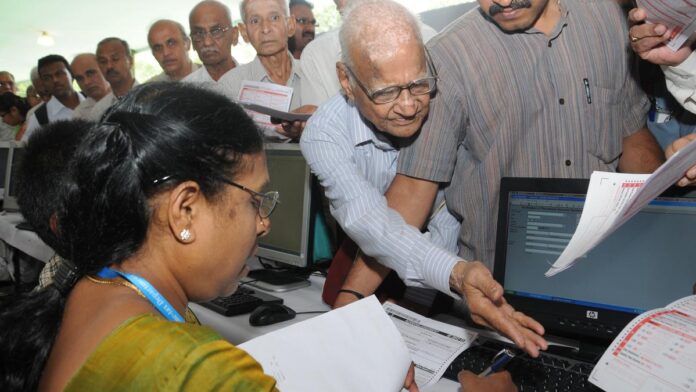
Senior citizens filing their Income-Tax returns, at the special counters in Bengaluru. File photo
| Photo Credit: K. Gopinathan
There has been a surprising surge in income tax payments from senior citizens during the past year, lifting the overall tax collections from the 60+ population by as much as 61.5% from pre-COVID levels to surpass ₹1 lakh crore.
While personal income tax flows have grown at a faster pace of around 24% vis-a-vis corporate taxes (up 16.9%) through 2022-23, the growth in revenues from senior citizens is far higher. In the first 11 months of 2022-23, taxes paid by senior citizens jumped 35.5% from the ₹83,756 crore collected from them in the entire previous year, to well over ₹1.13 lakh crore.
Also read: Senior citizens, families to see small gains in small savings
By contrast, taxes yielded by those in their golden years had risen 5% in 2021-22 and 13.6% in 2020-21, when these collections were under ₹80,000 crore. While taxes collected from senior citizens have already risen over 61% between 2019-20 and 2022-23, the number of such taxpayers increased 18.6% over the same period from 73.1 lakh to 86.71 lakh, as per official Finance Ministry data.
Tax practitioners are puzzled by this sharp rise in revenues flowing from this demographic, but believed a combination of factors may have driven this uptick. Those probable causes include arrears paid to defence pensioners, higher capital gains and dividend tax collections due to changes introduced in recent Budgets, along with the boom in the stock markets over 2021-22, whose tax dues were payable last year.
“This is very interesting data and it is hard to narrow the reasons for this phenomenon down precisely, but there could be a variety of catalysts at work,” noted Kuldip Kumar, personal tax expert and former national leader of the global mobility practice at PwC India.
“It could be that the new entrants into the senior citizens’ category in recent years have retired with higher incomes and savings relative to their peers who quit the workforce earlier,” Mr. Kumar reasoned.
Moreover, as fixed deposit returns remained low in the past, that may have nudged these taxpayers to move some savings into equities and mutual funds in the quest for better returns.
Such investors did see a surge in valuations, particularly those who would have invested around the time when the market took a dip during the COVID-19 pandemic. Those who cashed out would have paid capital gains taxes and that is reflected in the tax collection buoyancy to that extent, Mr. Kumar added.
The same quest for returns may have pushed more senior citizens to rely on dividend incomes from stocks, emphasised Aravind Srivatsan, tax leader at Nangia Andersen. “The change in the dividend tax regime from 2020 that made such payouts taxable in the hands of investors has also likely pushed up their tax payments,” he told The Hindu.
“To some extent, children investing in their parents’ name could also have influenced higher tax liabilities. I also think a lot of this rise in tax collections from senior citizens may have to do with implementation of the One Rank One Pension solution for defence retirees,” Mr. Srivatsan reckoned.
About ₹57,000 crore had been paid out in the first eight years since the implementation of the One Rank One Pension (OROP) system for Armed Forces pensioners and family pensioners with effect from July 1, 2014.
Over 2022-23, OROP arrears amounting to ₹1.2 lakh crore had been remitted by February 2023, as per Defence Ministry submissions to the Supreme Court. However, those payments will translate into tax liabilities in the current assessment year 2023-24.
Vivek Jalan, partner at Tax Connect Advisory, said it appeared to be a case of formalisation of the economy with more details about incomes being automatically captured and disclosed in the Income Tax system. However, the source of such income and the heads of disclosures needs to be seen, he said.
Mr. Srivatsan said he doesn’t expect this upward trend to last too long as many senior citizens may find it feasible to switch to the new personal income tax regime that exempts income upto ₹7 lakh a year.
However, with more OROP arrears payable in the coming year and the government doubling the investment limit for taxable investment options like the Senior Citizens Savings Scheme and the Monthly Income Account Scheme to ₹.30 lakh and ₹.9 lakh, respectively, a continued upswing in taxes from the elderly cannot be ruled out yet, others noted.
“Few may recall that in 2011, under then Finance Minister Pranab Mukherjee, the Central Board of Direct Taxes had reviewed the scrutiny selection procedure and held that senior citizens will only be subject to scrutiny in case the department has ‘credible’ information,” Mr. Jalan pointed out.
#Tax #paid #senior #citizens #surges #lakh #crore
